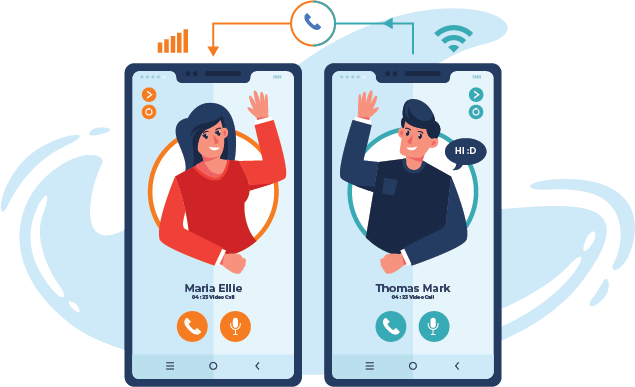Why VoWiFi is more compelling now
A recap: The case for VoWiFi over the years
Voice over WiFi (VoWiFi) or WiFi Calling is based on widely-accepted GSMA standards and has been deployed successfully as early as 2014 in the USA by AT&T. In the early years of adoption, VoWiFi was one of the best ways to solve coverage problems by leveraging on existing WiFi access points without incurring huge investments to expand the Telco’s RAN (Radio Access Network). VoWiFi or WiFi Calling uses the wireless internet as the mode of transmission for calls, SMS, and MMS, without any need for a third-party app if it is supported natively on the mobile device. It basically allows a mobile user to use the same phone number and the same smartphone dialer interface. The recipient can be on any network (2G/3G/4G/VoLTE/WiFi).

VoWiFi Addresses Capacity Issues for Network Operators
One reason why VoWiFi is even more relevant today is its ability to solve capacity problems. Mobile operators can provide better service by offloading traffic from the mobile network to the readily available WiFi hotspots provided by homeowners and establishments. Think of it this way: On a rush hour, everyone is using the main road so traffic is slower. VoWiFi is like opening a wider road for other people to use to relieve the congestion. Because traffic is offloaded to WiFi, a lot of people do not have to suffer poor service quality brought about by congestion. Everyone gets to stay connected, calls are clearer, and the flow is smoother.
VoWiFi: Cost-Efficient Roaming for Subscribers and Potential Revenue for Operators
Roaming cost has generally been high for subscribers since time immemorial. This is why many prefer to buy prepaid SIM cards when abroad. For smaller Telco operators or MVNOs that do not have good roaming agreements with Telcos abroad due to size and volume, this becomes a potential loss since their customer will not be using their service. Some operators may choose to offer VoWiFi as a free VAS (value-added service) to attract customers or disable the roaming of VoWiFi services abroad. However, other astute Telcos may use VoWiFi to enhance their service offerings to their subscribers.
In the Indo-China region, a Telco that is using ANTlabs carrier solution has been enabling its subscribers to text and make calls over WiFi with lower call tariffs instead of using regular international roaming services. With VoWiFi, they were able to charge subscribers a fraction of the usual roaming charge. This is a win-win situation for both the subscriber and the operator. The operator still maintains having their subscribers with them while abroad, while the subscriber benefits from this by getting lower rates.
VoWiFi reduces the churn to prepaid service of roaming operators and enables them to offer exclusive services to their roaming subscribers at cheaper roaming rates—all these while retaining their customers. Our anecdotal experience suggests that charging 20% of normal roaming rates for VoWiFi may be palatable and welcome by subscribers.
ANTlabs VoWiFi Solution
ANTlabs enables service providers to provide end-to-end solutions, such as VoWiFi, that are secure, reliable, easily integrated, and flexible. Our VoWiFi / WiFi Calling solution has native dialer support, S2b interface with GPRS Tunneling Protocol, and works on both trusted and untrusted WiFi networks.
ANTlabs carrier solutions allow service providers to easily adapt to the explosive growth of complex networks. With our high capacity, high performance, AAA, DHCP, DNS, and IP management solutions, ANTlabs enables Telcos to provide reliable connectivity with low latency.
So why is VoWiFi more compelling now?
Today in places with high population, we see major Telcos aggressively deploying VoWiFi to solve mobile coverage issues for their millions of subscribers. In the past, only high-end mobile phones from Apple and Samsung support VoWiFi natively. It is no longer the case at present. More mobile phone models from low price points to high-end models support VoWiFi natively out of the box in recent years, thus, setting the stage for widespread adoption.

5G is on the horizon and as it becomes mainstream, so will the number of connected devices increase, and high bandwidth streaming usage rise. It is widely acknowledged that indoor coverage of 5G network will be worse off than existing 3G/4G networks, and more expensive to expand. Therefore, the need to offload the data and voice calls to better indoor WiFi will be even stronger.
While the COVID-19 pandemic in 2020 has dramatically reduced travel, even more people are connected through the Internet because of physical restrictions. Working from home and home-based learning have become the new normal.
VoWiFi enables subscribers to stay connected even if network coverage in the area is not good. Good connectivity helps keep businesses stay open safely and keeps people up to date with what and who matters to them. The need for VoWiFi to improve quality of service for subscribers while keeping the cost low for operators in these economically challenging times, has never been more prevalent to keep up with the demands.
As travel restrictions are slowly lifted, we see essential business travel picking up with more green lane travel arrangements between countries. Business travelers will appreciate the seamless and affordable VoWiFi services even more. In our future article, we shall explore how HotSpot 2.0 technology with its seamless onboarding, can make VoWiFi even more accessible once this technology has been widely adopted.
Talk to us today to know more about our carrier solutions.
About ANTlabs
ANTlabs is a leading technology innovator for guest network technology and services for 20 years. Established in 1999 and based in Singapore, ANTlabs products have been used globally in hotels, airports, telecommunications companies, stadiums, and convention centers.
Media Contacts
ANTlabs Marketing Department
Tel: +65 6858 6789
Email: media@antlabs.com
URL: www.antlabs.com

